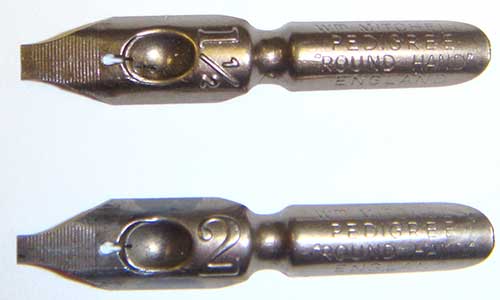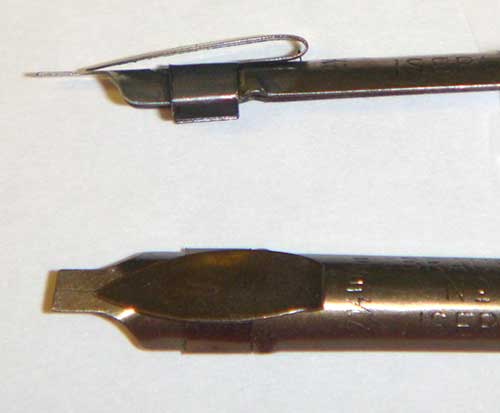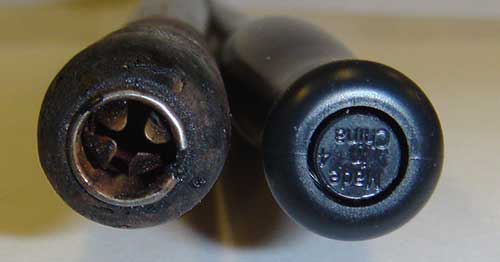Dip pens can be a little challenging for beginners or for those moving from a calligraphy fountain pen or calligraphy marker. One of the most common problems is getting the ink to flow consistently from the nib – either not flowing enough (scratchy or skipping) or flowing too fast (blotting).
These are just a few troubleshooting tips when having problems with dip pens – by no means a comprehensive list, but a few common issues that are easy to resolve.
For more information on how to use a dip pen refer to the Care and Feeding of the Calligraphy Dip Pen post.
Pen Nibs
New Nibs
A new nib will have a coating on it that will need to be removed as it will interfere with ink flow. The coating is done at the manufacturing level to keep the metal nibs from rusting (you wouldn’t want to buy a rusty nib!)
There are several ways to do this – some more complex than others – but generally a good scrubbing with an old, soft toothbrush and a bit of dish washing liquid, baking soda, toothpaste or ammonia will do the trick.

New Nib (top) and Nib with Coating Removed (bottom)
As the picture indicates, the top nib appears a bit shinier with the coating and duller with the coating removed (bottom nib.) Once the coating is removed the nib is susceptible to rust, so it is important to clean and thoroughly dry the nibs after use.
Damaged Nibs
Inspect the nib to ensure the tines are not bent or overlapping. This can happen with nibs that are thin (small nibs sizes) and flexible. If the bending or overlapping is not too severe, the tines can sometimes be pushed gently back into place. If the tines are severely bent it might be time to replace the nib.
Eventually, nibs might wear down and won’t produce crisp, clean pen strokes. Sometimes they can be gently sharpened using an Arkansas (white) sharpening stone – just be sure that the nib isn’t so sharp that it cuts the paper!
Rusty Nibs
I haven’t found anything that will “cure” rust on a nib other than simply replacing the nib. Hans Presto suggests a fibreglass brush for removing dried paint, and since they are used to remove rust on vehicles it might be worth a try if you are determined to save that nib and the rust isn’t too severe.
A few handy “pen nib care” tools that could be useful in your calligraphy work area or art box – pen cleaner, sharpening stone and an old tooth brush.

Pen Cleaner, Sharpening Stone and Old Toothbrush
A more expensive alternative for cleaning pen nibs is a small ultrasonic cleaner with a pen cleaning solution. They will do an excellent job of cleaning all types of pen nibs, technical pens etc. and might be worth the investment for professionals who do a high volume of work.
Reservoirs
The reservoir is what holds the ink and feeds it to the nib. Pen nibs generally come in two varieties, a reservoir attached to the top (Brause, Tape, TO, Speedball, etc.) or attached to the bottom (Mitchell). The reservoirs are held onto the nib with metal prongs that should keep the reservoir firmly attached to nib without sliding or falling off.
If the reservoir can be removed (most nibs except the Speedball nibs) then disassemble the nib and clean the reservoir. Ink can build up and cause the ink to flow unevenly or might also mix dried ink bits into the ink.

Nibs and Reservoirs
Some brands have a molded “lip” built into the nib (or what could be called a “reservoir indicator), and I have found that this is usually the best place for the reservoir. When attaching the reservoir back onto the nib, make sure the reservoir is fitted back to this position with the top of the reservoir prongs up to the extended “lip”.

Brause Nib with Molded Lip
The reservoir tip should just be touching the nib and centered, not flat against it or pushed to the side. If this still isn’t working well, try moving the reservoir down a little below the lip.

Reservoir Position on Brause Nib

Reservoir on Mitchell Nib
If you are having problems getting the ink to flow with the reservoir, try removing it and loading the back of the nib with a bit of ink and try a few pen strokes. When you can produce a few decent strokes (adjusting hand pressure, different type nib or ink, etc.) re-attach the reservoir and try again.
Hand Pressure
Dip pens might require a little more hand pressure to get the ink flowing than would normally be used for a calligraphy fountain pen or marker. Some nibs, such as the Brause, are quite stiff while others, such as the William Mitchell, are more flexible.
If you find you have to put a lot of pressure on the nib then try a more flexible type, especially if the tines are splaying because of heavy hand pressure.
The reverse problem would be using a too flexible nib with normal hand pressure that would cause the tines to splay, the ink to flow very quickly and blot, in which case a more stiffer nib would be worth trying.
Since there are quite a wide variety of nibs available, take the time to try a few until you find one that works comfortably and well for your writing style and hand pressure.
When lettering, make sure the full width of the nib is on the paper. A few nibs, such as the Brause, are cut at an angle, others such as the Michell are straight cut. You can adjust the angle you hold the pen if the pen strokes are ragged because the full width of the nib is not on the paper, or try a different cut of nib that works better with the way you hold the pen.
Pen Holders
There are many varieties of pen holders available – generally constructed of plastic or wood, some have cork or molded grips – selecting one is a matter of personal preference.

Two Examples of Pen Holders - Plastic (top) and Wood (bottom)
All that should be required is that is it comfortable in your hand and holds the nib securely. Some have metal tabs, some have a slot cut around the base to slide the pen shank.

Pen Holders with Metal Tabs (right) and Slot (left)
The slot varieties are easy – just push the nib shank anywhere around the slot and slide it up until it is secure.

Nib in Holder with Slot
Metal tabs are a little different – the nib is pushed between the tabs and the barrel – not “centered” in the tabs. A nib centered in the tabs is not secure and will “wiggle”.

Correct and Incorrect Placement of Nib in Metal Tab Holder
Ink
The type and character of the ink can also effect ink flow – too thin will cause the ink to flow quickly and blot; too thick will feed the ink more slowly and skip or not flow at all.
Fountain pen ink is generally too thin for dip pens, try an ink specifically marked for Calligraphy. These will be a little more dense than fountain pen ink and will flow better from a nib. Try to avoid inks containing shellac as this will cause the ink to dry very quickly and will gum up the nib and reservoir.
Calligraphy inks also come in a wide variety of densities – Higgins Eternal is an excellent “medium” density ink that should flow well from the nib for beginners, or try a non-waterproof calligraphy ink as these will dry less quickly. Once you are comfortable using a dip pen, there is an exciting world of inks to try!
For more information on inks refer to the Selecting Calligraphy Inks: Tests and Reviews post.
Papers
When troubleshooting a dip pen, try your tests on a smooth, sized paper. Textured papers might let the pen nib “skip” and won’t produce a clean line, and unsized papers might make the ink “bleed” into the fibers, or catch paper fibers in the nib.
Any smooth paper for ink (e.g. sketchbook paper) will be suitable for testing your pen and ink combinations.
More information on papers can be found at the Papers for Calligraphy post.
Test Strokes
Try a few vertical pen strokes (top to bottom) and some horizontal pen strokes (left to right) if right-handed (left-handed might want to reverse the strokes.) Basic Stroke examples can be found at the Stroking the Rules post.
When you find the right combination of pen nib, reservoir and ink to produce clean strokes, try lettering a few words. A nib reservoir will typically hold enough ink to produce a few letters before requiring a “recharge” of ink.
Making it all work together
There are many variables that can cause problems lettering with dip pens – new coated nibs, old worn out nibs, nib cut, reservoir position, pen holders, hand pressure, ink and paper – take some time trying different combinations before finding the best “fit” for your lettering style.
Fortunately, there are a wide variety of tools available – sometimes what comes in a calligraphy set might not be the right combination for you – pen nibs, holders and ink can be purchased individually at a relatively low cost, so if what you have doesn’t work, it might be worth trying something different.
Calligraphy should be fun and enjoyable – you shouldn’t have to “fight” with your pen!